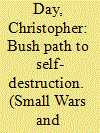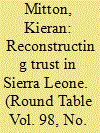|
|
|
Sort Order |
|
|
|
Items / Page
|
|
|
|
|
|
|
| Srl | Item |
| 1 |
ID:
142609


|
|
|
|
|
| Summary/Abstract |
This article explains the demise of Sierra Leone's Revolutionary United Front (RUF) rebellion. It argues that the main cause of this fate was the group's relationship with its primary sponsor, Charles Taylor. The RUF's dependency on Taylor's patronage, coupled with the rebellion's weak organisational endowments harmed the group's prospects of success. Based on original research, the article shows how Taylor used the RUF as a strategic instrument for his own regional interests, which led to the group's unravelling. More broadly, the article speaks about proxy warfare in Africa and how the relationship between resource flows and rebellion are not always beneficial to rebels as one might expect.
|
|
|
|
|
|
|
|
|
|
|
|
|
|
|
|
| 2 |
ID:
089416


|
|
|
|
|
| Publication |
2009.
|
| Summary/Abstract |
In 2004, Sierra Leone's Truth and Reconciliation Commission reported that building public trust in Sierra Leone's post-conflict government and political system was a precondition for development in all sectors of society. This article assesses progress in this venture, and finds that problems of deep distrust continue to pervade all levels of socio-political interaction in Sierra Leone. Nevertheless, the manner in which political trust is conceptualised in Sierra Leone is changing as traditional inequitable systems of patronage are gradually rejected. Noting this trend, it is a central argument of this article that the channelling of prevailing political cynicism into mechanisms of accountability, combined with the earning of public trust by exemplary political leaders, represents the most effective way to reconstruct trust in government, the political system, and throughout Sierra Leone in general.
|
|
|
|
|
|
|
|
|
|
|
|
|
|
|
|
| 3 |
ID:
126446


|
|
|
|
|
| Publication |
2013.
|
| Summary/Abstract |
Contemporary understandings of rape in wartime emphasise its strategic deployment as a weapon of war. One of the most prominent cases in the discourse has been the Sierra Leone Civil War and its Revolutionary United Front (RUF) rebel group. This article complements the existing literature by examining war-related sexual violence from within the rebel group itself, exploring how sexual violence was used and understood by fighters. Counter-intuitive to received wisdom that the RUF instrumentalised rape systematically, extensive interview and archival material show that there were harshly inculcated, but ultimately ineffective policies aimed at preventing rape. These laws were central to the RUF's attempts to manage organisational control and cohesion. This calls for revisiting and revising the 'rape as a weapon of war' framework if it is to have explanatory power for the causes and mechanisms of gender violence in war.
|
|
|
|
|
|
|
|
|
|
|
|
|
|
|
|
| 4 |
ID:
123040


|
|
|
|
|
| Publication |
2013.
|
| Summary/Abstract |
In November 1996, one of Africa's cruelest insurgent leaders, Foday Sankoh, conceded defeat and agreed to sign a peace treaty with the Government of Sierra Leone to halt that country's then-seven year long civil war. Sankoh's decision to stop fighting was not born out of a sense of goodwill toward his government or a shift in his political objectives. Rather, he agreed to make peace because his thousands-strong insurgency, the Revolutionary United Front (RUF), had been soundly defeated in a series of clashes against Executive Outcomes (EO), a mercenary force that fielded a mere 250 personnel. Seeking to explain this turn of events, a number of scholars have alleged that the mercenaries prevailed because they had access to more and better weapons than the RUF and, thus, made up for their lack of men with superiority in materiel. 1 Christopher Wrigley, for instance, argued that Executive Outcomes defeated the RUF, 'because it relied on sudden strikes made possible by its helicopters, which provided both transport and covering fire'. 2 Abdel-Fatau Musah, similarly, argued that EO succeeded in Sierra Leone because its 'air power' allowed it to deal, 'telling blows to the RUF on several fronts'. 3 Referring not only to EO's air assets, but also to its armored infantry fighting vehicles, Elizabeth Rubin concluded that the RUF, 'were overwhelmed by EO's superior firepower'. 4 Jacob Akol, likewise, concluded that, 'the RUF were overwhelmed by EO's firepower'. 5 These opinions are well-known to the mercenaries who took part in this conflict, one of whom acknowledged that, 'the world thinks that Executive Outcomes was successful because of the use of overwhelming technology and superior firepower'.
|
|
|
|
|
|
|
|
|
|
|
|
|
|
|
|
|
|
|
|
|